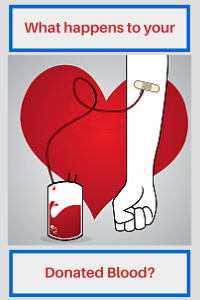 Every 2 seconds someone needs blood. That’s 43,000 pints of blood a day. Donated blood contains many life-saving components that can help to treat different illnesses and injuries. For many, blood donors are the reason a life is saved. Blood donation also benefits the donor by reducing the chances of heart diseases and frequent donations reduce the accumulated and unwanted iron load from the body.
Every 2 seconds someone needs blood. That’s 43,000 pints of blood a day. Donated blood contains many life-saving components that can help to treat different illnesses and injuries. For many, blood donors are the reason a life is saved. Blood donation also benefits the donor by reducing the chances of heart diseases and frequent donations reduce the accumulated and unwanted iron load from the body.
Blood donation takes only about 45 minutes. This includes registration and a few minutes of rest after. Healthy adult donors who meet the required screening criteria give about 10-12% of their circulating blood volume during each blood donation.
“Donate blood and save lives” – You’ve read it and heard it more times than you can count. Most people leave from donating and never really think about what happens next.
So what happens to donated blood?
You’re blood is taken in specific amounts. There is the main unit of 480ml (a little less than a pint) and several test tubes. The test tubes are sent to the head office for more testing.
The whole blood donations are separated into three essential components—red cells, platelets, and plasma.
- Red blood cells – make up roughly 45% of blood volume. A few drops of whole blood contain about one billion red blood cells. They carry oxygen throughout the body and are used to help trauma victims, surgical patients, anemia, and people battling cancer.
- Platelets – blood cells that help control bleeding. Plasma forms a clot and allow the wound to heal. Only a small amount can be extracted from whole blood donation and there are typically donations specifically for platelets. Many receiving bone or organ transplants as well as cancer patients need platelet transfusions to survive.
- Plasma – is a pale yellow mixture of water, proteins, and salts that constitutes 55% of blood volume and promotes clotting. Usually used to help burn victims, liver transplant recipients, and patients suffering from shock or bleeding.
Every time someone donates blood samples are taken for testing. They are tested for the donor’s blood group, which includes identifying the ABO type and a positive or negative Rh factor, and safety. Safety test can detect hepatitis B and C, HIV, syphilis, and other unexpected antibodies.
The blood is processed through many devices and machines. First the white cells are removed from the blood, Blood is spun around in large centrifuges. The red cells which are heavy sink to the bottom and plasma, the yellowish liquid stay at the top and platelets settle in the middle. Each component is then physically separated from each other using a blood separator.
Once all the necessary processing of all the components is complete, the blood is stored. Platelets are stored on an agitator that keeps them constantly in motion. While red cells are stored in large fridges at 4 degrees Celsius. Red blood cells have a shelf life of 42 days, platelets 5 days, and frozen plasma for one year.
The final step is waiting on the call from a hospital. They crosscheck patients information with their system and the blood goes out.
Interesting facts:
- One pint of blood can save up to three lives
- AB is the universal recipient; O negative is the universal donor of red blood cells.
- 2.7 pints: the average whole blood and red blood cell transfusion
- Blood centers often run short of types O and B red blood cells
- If only one more percent of all Americans would give blood, blood shortages would disappear for the foreseeable future
- Blood makes up about 7 percent of your body’s weight
